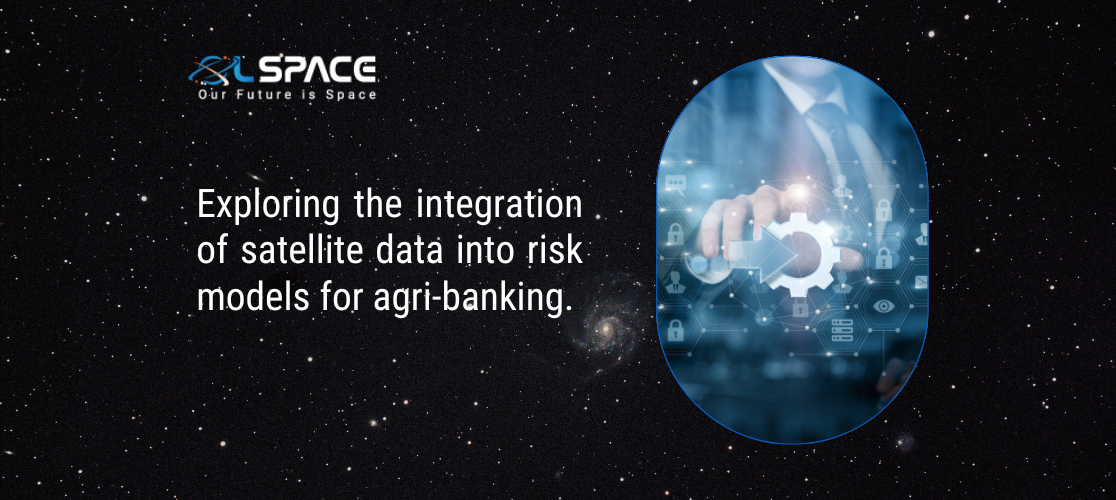19 January 2024
Exploring the integration of satellite data into risk models for agri-banking.

In the dynamic landscape of agri-banking, the integration of satellite data into risk models has emerged as a transformative approach, offering unparalleled insights into agricultural practices and environmental conditions. This article explores the synergy between satellite data and agri-banking risk models, shedding light on how this integration enhances precision, mitigates risks, and contributes to sustainable agricultural financing.
1. Crop Monitoring and Yield Estimation:
Vegetative Indices Analysis: Satellite-derived data, such as normalised difference vegetation index (NDVI), aids in monitoring crop health and estimating yields. Agri-banking risk models leverage this information to assess the financial impact of potential yield variations.
Timely Identification of Issues: Early detection of anomalies, diseases, or adverse weather effects through satellite data enables agri-banks to proactively assess risks related to crop performance and adjust financing strategies accordingly.
2. Weather and Climate Risk Assessment:
Climate Pattern Analysis: Integration of historical weather data from satellites allows agri-banking risk models to analyse climate patterns, identifying regions prone to extreme weather events. This helps in assessing the vulnerability of agricultural operations to climate-related risks.
Insurance Product Development: Satellite-informed risk models assist in the development of weather-indexed insurance products. Agri-banks can offer customised insurance solutions based on real-time climate data, protecting both farmers and financial investments.
3. Soil Health and Fertility Analysis:
Soil Composition Mapping: Satellite data provides insights into soil health and composition. Agri-banking risk models utilise this information to evaluate the long-term sustainability of agricultural practices, influencing lending decisions based on soil fertility and management practices.
Precision Agriculture Financing: By considering soil health data, agri-banks can tailor financing solutions for precision agriculture practices, promoting sustainable and resource-efficient farming.
4. Land Use and Crop Rotation Planning:
Satellite Imagery for Land Use Mapping: High-resolution satellite imagery aids in mapping land use patterns and crop rotations. Agri-banking risk models incorporate this data to understand the diversification of crops on a farm, influencing loan terms based on the risk associated with different crops.
Diversification Impact Analysis: Assessing the impact of crop diversification on farm income and risk exposure allows agri-banks to develop risk models that encourage sustainable agricultural practices.
5. Pest and Disease Outbreak Monitoring:
Remote Sensing for Pest Detection: Satellite data facilitates the early detection of pest and disease outbreaks. Agri-banking risk models factor in the potential financial losses associated with these outbreaks, influencing risk assessments and loan terms.
Financing Resilience Measures: Agri-banks can proactively finance pest and disease resilience measures based on satellite-derived information, contributing to more sustainable and resilient farming practices.
6. Water Management and Irrigation Planning:
Satellite-Derived Water Availability Data: Integrating satellite data on water availability supports risk models in assessing the adequacy of irrigation practices. Agri-banks can evaluate the financial implications of water scarcity or excess and adjust lending strategies accordingly.
Sustainable Irrigation Financing: Agri-banking risk models promote sustainable irrigation practices by considering water-use efficiency and encouraging investments in water-saving technologies.
7. Compliance Monitoring for Sustainable Practices:
Satellite Observations for Compliance Verification: Agri-banking risk models can use satellite data to verify compliance with sustainable agricultural practices and environmental regulations. This ensures that financing is aligned with eco-friendly and socially responsible farming.
Green Financing Incentives: Agri-banks may offer preferential terms for loans to farmers who adopt sustainable practices, as verified by satellite data, contributing to a more environmentally conscious and responsible agri-banking ecosystem.
Conclusion: Transforming Agri-Banking with Satellite Data Integration
The integration of satellite data into agri-banking risk models marks a pivotal shift toward more informed, sustainable, and resilient financial strategies in the agricultural sector. By harnessing the power of satellite observations, agri-banks can enhance risk assessments, tailor financial products, and promote practices that contribute to both agricultural productivity and environmental sustainability. This holistic approach not only benefits the financial institutions but also fosters a positive impact on farmers, fostering a more secure and sustainable future for agri-banking.
